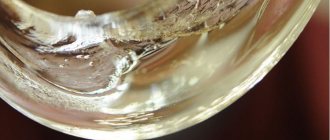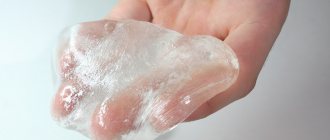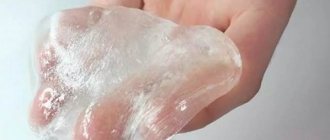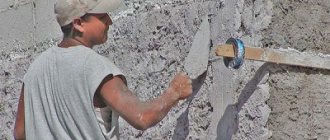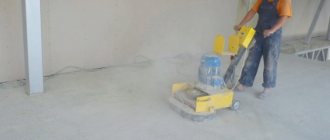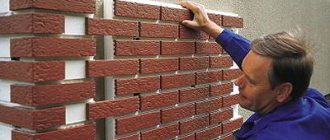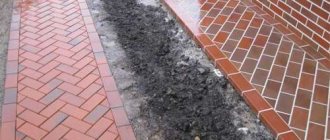In order to give concrete additional properties, various substances and solutions are added to it. To ensure faster tenacity, water resistance and moisture resistance, it is customary to add sodium or potassium silicate, which is called soluble or liquid glass. For concrete, it is used as part of a cement mixture necessary for waterproofing concrete surfaces. This article will tell you about the features of the material and the rules for its use.
Liquid glass can impart additional properties to concrete
Composition and scope of application of liquid glass in concrete
The phrase “liquid glass” is familiar to many, but not everyone knows what this mixture consists of and for what purpose it is used. An aqueous solution of potassium or sodium silicate was discovered by alchemists in the Middle Ages, but the first plant for its production appeared only in the 19th century. Then its widespread use in the construction industry began.
Liquid glass consists of an aqueous solution of sodium or potassium silicate
The material is produced by fusing soda and sand or by combining proportions of ground silicon with hot caustic sodium. The output is a translucent viscous substance of white or yellowish color, called liquid glass. The solution may contain sodium or potassium silicates, as well as a mixture of them.
The material, which has different properties, is widely used in construction for waterproofing concrete surfaces. For this purpose, concrete is coated with liquid glass. A silicate solution is applied directly to the cement, which is absorbed into the surface. When the substance dries, all the pores of the concrete are clogged, protecting it from moisture penetration. The maximum effect is achieved by applying several layers of this composition.
This material is used as an admixture to concrete mortar. Concrete with the addition of liquid glass has a high degree of waterproofing and hardens much faster. Therefore, it should be used for a certain period of time. In addition, liquid glass is used to produce monolithic concrete blocks of various brands and sizes.
The use of the substance in various fields is due to the advantages of silicate material, among which are:
Liquid glass is used in the construction industry; it can be used alone or added to concrete
- high degree of penetration and adhesion;
- the formation of a solid waterproof film on the surface of the coated material;
- low consumption of substance in solution;
- reasonable price of the product.
Why is liquid glass added to concrete: the feasibility of using the material
The main quality of concrete mortar with the addition of liquid glass is that the mixture sets quickly and provides a high degree of protection from moisture. However, it should be noted that the strength of the monolithic structure decreases after this.
Helpful advice! The use of a cement mixture with the addition of liquid glass will allow you to successfully repair structures made of concrete, asbestos cement, ceramics, and even restore cast iron pipes.
It is most advisable to use silicate concrete mortar for the following needs:
The main function of liquid glass is concrete waterproofing
- sealing cracks with liquid glass in concrete, brick walls, for insulating seams;
- urgent repair of a concrete foundation that has collapsed from excessive exposure to moisture;
- strengthening concrete with liquid glass in ceilings, for connecting beams and other elements.
In these cases, liquid glass is added to the cement solution in a ratio of no more than 1:1. Next, mix a little solution and use it immediately, since the mixture of cement and silicate dries very quickly. The correct ratio of substances will allow you to permanently eliminate defects or give additional strength to concrete structures.
Adding liquid glass to concrete is appropriate when creating a foundation in areas where the soil contains a high level of acidic water. This guarantees increased resistance of concrete to the destructive effects of moisture. Successful pouring of such a foundation is ensured by the following rules:
- the addition of sodium silicate to the concrete solution should not exceed 3%;
- They carry out additional and thorough waterproofing of the foundation using other materials.
Using liquid glass you can strengthen concrete, seal cracks, and insulate joints
What is liquid glass?
The impregnating preparation, according to GOST 13078-81, is made from quartz sand or with the addition of sodium [1]. The substance is an adhesive, viscous composition obtained by firing quartz sand or by the autoclave method. They first started talking about the drug 200 years ago; it was invented in 1818, since then the manufacturing method and composition have not changed. Liquid glass is used in construction for processing internal and external concrete surfaces of industrial and private buildings.
What is liquid glass used for?
By its nature, cement has a porous structure through which moisture enters and destroys the structure. To protect products from environmental influences, builders often use various additives, among which silicate glue is the most widely used. It is made in the form of a water-based solution, the main components are potassium and sodium silicates. After drying, a polymer film is formed that prevents moisture from penetrating deep into the pores of cement mixtures.
Liquid glass improves the quality of concrete, increases the strength of structures, and has high waterproofing properties. The adhesive composition based on silicates has the following characteristics:
- waterproofing is the main parameter of impregnation;
- the drug accelerates the concrete hardening process several times;
- the polymer layer protects the building from static electricity;
- the alkaline solution protects the wall from the spread of fungus, mold and other cultures that adversely affect the structure.
There are two types of glass available for sale: potassium-based or sodium-based. Potassium glue is made from crushed quartz sand, which is fired during the process, and the powder is mixed with water. This composition is often used for waterproofing the foundations of buildings and swimming pools. Due to its antiseptic properties, the drug is used as an antiseptic to combat mold and chemically aggressive environments.
In addition to potassium glue, sodium impregnations are often used. They have less protective properties, in particular against salt deposits, but due to the low cost of the products they are more in demand on the market. The composition is produced both using autoclave technology and without it.
Liquid glass for concrete: instructions for use and preparation of the mixture
You can prepare a mixture of cement and liquid glass even at home, while observing a number of requirements. Violation of the mortar manufacturing technology can lead to the formation of cracks in concrete.
Liquid glass should be added to the dry mixture. To do this, first combine all the dry ingredients in the required proportions and mix them thoroughly without using water. Then liquid glass, previously diluted with water, is gradually poured into the composition.
It is necessary to strictly observe the ratio of all ingredients when preparing the solution in accordance with the recipe used for a specific type of work. For example, if we are talking about the amount of glass in concrete, then it should not exceed 25% of the total weight of the mixture. To prepare a primer using a cement composition and silicate glue, the ratio can be 1:1.
It should be taken into account that it is liquid glass for concrete that accelerates the speed and density of hardening of the solution. The instructions for use recommend preparing the mixture in small quantities and using it quickly.
To waterproof the concrete surface, liquid glass is applied in several layers
The setting time depends on the amount of liquid glass added to the concrete. If the mixture contains 2% of this substance, then it begins to set within an hour, if 5%, then after 40 minutes. The hardening process also depends on the proportion. If more than 4% silicate glue is added to the solution, the strength of the concrete after complete hardening will decrease by about 25%. However, if the concrete contains only 3% liquid glass, the strength of the structure will increase.
Helpful advice! Sodium silicate, in addition to its waterproofing function, has antibactericidal and antifungal properties. The chemical composition of the material is an unsuitable environment for the development of any life.
Technological features of the mixture and types of impregnation of concrete with liquid glass
Liquid glass in a solution mixed in M400 cement at a temperature of 20 ° C begins to set after 2-3 hours, and completely hardens within a day. Over time, the monolithic base will only become stronger. The maximum hardness effect is achieved after a maximum of 4 weeks. Liquid glass is also used as an impregnation of various surfaces, ensuring their smoothness, evenness and waterproofing. Treatment of concrete with liquid glass is carried out for the following structures:
- concrete floor;
- flat roof;
- wells;
- swimming pools;
- basements;
- plinths;
- concrete walls and ceilings.
After the liquid glass dries, all pores in the concrete become clogged.
The impregnation process includes several stages. First of all, preparation of the base is required. To do this, the surface is thoroughly cleaned of old coating, paint, debris, dust and dirt. Next, the surface is cleaned with a metal brush and the base is covered with a 2 mm layer of bitumen emulsion. The base is given time to dry.
Then the surface is impregnated with a solution of liquid glass. The proportions of liquid glass in concrete depend on the type of surface (in accordance with the instructions for use). If the surface is horizontal, then a layer of 2-3 mm is applied to it and the mixture is smoothed with a spatula. The floor and ceilings are poured in several layers, taking a break for a certain number of hours. The surface can be used after a couple of days.
During work, you need to adhere to a number of recommendations. In particular, the solution must be distributed evenly. The coating should be done as quickly as possible, without allowing the composition to harden. Reliable impregnation is ensured by applying the mixture in two or even three layers. To insulate walls and ceilings, use a special spray bottle, which promotes uniform distribution of the solution. Cover the surface in two or three layers.
How to choose liquid glass for waterproofing
There are several types of liquid glass on sale. They are selected for different needs. The presence of sodium silicate in the composition is better suited for creating a barrier against water. Potassium silicate is better suited to create fire protection against fire on wooden material, it also has antiseptic and vapor permeable properties.
Potassium silicate is better suited to create fire protection on wood material.
How to cover a concrete floor with liquid glass
Liquid glass is used not only for priming and impregnation of surfaces, but also as a coating. For this purpose, a special solution is prepared, including finely ground filler, sand, and active silica, liquid glass and water are added to it. The ingredients are mixed with a construction mixer. The resulting substance should be viscous and thick.
Before applying liquid glass, it is necessary to carefully level the surface of the concrete floor
Solutions with liquid glass for concrete floors are used to apply a protective waterproofing layer to floors, walls and ceilings in rooms with high humidity: bathrooms, saunas, laundries, swimming pools or baths. It is also recommended to use these mixtures in basements.
Before applying liquid glass to concrete, the surface to be treated is thoroughly cleaned and leveled. As a finishing coating, liquid glass is used in the form of a strong hydrophobic solution. The surface is covered by pouring onto screeds, which are formed by planks installed parallel to the wall.
Helpful advice! Liquid glass has high thermal conductivity. Therefore, the material is often used to provide additional thermal insulation. Adding liquid glass to concrete in the right proportions provides high thermal insulation of the surface, which can withstand temperatures up to 1200 °C.
The quality of work depends on the uniform distribution of the material. This can be done using a special needle roller, a spatula and a squeegee with an extended handle. The layer size is 2-4 mm. Considering the short drying time of liquid glass on concrete, the work must be done quite quickly. To do this, it is better to divide the covered area into sections, and the whole process into several stages. After preparing the floor surface, the concrete is painted with liquid glass.
You can apply liquid glass to a concrete floor using a roller, spatula or squeegee.
How to prepare a solution with liquid glass
The ratio of solvent to glass can be varied. Here you should study the instructions on the packaging. Because an individual brand may have different requirements. It is better to dissolve the material using a construction mixer, then it will be easier to obtain a homogeneous solution.
It is better to dissolve the material using a construction mixer, then it will be easier to obtain a homogeneous solution.
How much liquid glass to add to concrete: recipes for preparing compositions
Depending on the purpose of using liquid glass, proportions are drawn up. The main thing in this matter is responsibility and accuracy. The universal impregnation recipe provides for a mixture of silicate and water in a ratio of 1:2. There are several options developed by experienced builders that are time-tested.
If a silicate solution is used as a primer, then the mixture is prepared in 1:1 proportions (with cement and adding the required amount of water). That is, add 1 kg of liquid glass to 1 kg of cement and gradually pour in such an amount of water so that the resulting mixture makes it convenient to prime the surface. If the solution hardens quickly, you can add a little water to it after some time.
To waterproof wells, liquid glass is combined with carefully sifted sand in a 1:1 ratio. The resulting mixture is used to cover the walls of the well.
In underground concrete premises, reliable waterproofing will be ensured by adding liquid glass to concrete in the following ratio: 1 liter of silicate glue per 10 liters of cement mortar. This composition guarantees reliable insulation of walls and floors of basements located underground. The refractory mixture is prepared as a cement-sand mortar with the addition of a small amount of liquid glass.
The amount of liquid glass in concrete is calculated depending on the purpose of use
Antiseptic for wood is obtained in this way: mix liquid glass with water in equal proportions. In this case, a slippery protective film is formed on the wood, which cannot be painted. For this reason, this solution is not recommended for use on concrete walls.
Various types of impregnation are prepared, mainly based on the following proportions: 400 ml of liquid glass per 1 liter of water. The next layer is applied after 20-30 minutes - exactly after the same period of time as liquid glass dries on concrete.
The main pros and cons of liquid glass
The choice of whether to treat a surface with liquid glass is easier when the positive and negative aspects of the process are known. The following advantages of the material can be noted:
- Creating a film that does not allow moisture to pass through;
- High level of adhesion, penetration into any surface cracks;
- Economical consumption, can be added to cement mortar;
- Reasonable cost;
- Long service life;
- Resistant to a variety of substances.
The presence of a large number of advantages does not exclude the disadvantages:
- Incompatible with all materials, can only be applied to concrete and wood;
- The layer is brittle, additional product should be applied on top;
- It is not possible to apply over another finishing material; paints and varnishes do not adhere to it;
- Carrying out the application requires special skills; it is almost impossible for a beginner to do the job with his own hands;
- The product cannot be tinted.
The product dries very quickly, so the work requires a fast pace from the master.
The surface is rarely covered with liquid glass separately; it is usually combined with another waterproofing material, but the product helps to obtain high-quality protection on concrete and wooden bases.
The surface is rarely covered with liquid glass separately; it is usually combined with another waterproofing material.
Liquid glass for concrete: reviews from customers and experts
On the Internet you can find many reviews that characterize the silicate solution mainly on the positive side, although there are also negative opinions. In particular, the material is not considered environmentally friendly, and its use in violation of proportions can lead to cracking of the concrete surface. Some users do not like that the silicate-concrete mixture sets quickly. For example, there are cases when an inexperienced builder mixed cement mortar with the addition of liquid glass in a ratio of 25%. When pouring the screed, the mixture immediately froze, and a day later it simply crumbled into dust. I had to re-prepare the solution. In this case, the main mistake of the master is failure to comply with the proportions.
Silicate solution has both positive and negative reviews
Other reviews, on the contrary, characterize liquid glass as an excellent means for waterproofing screed. Craftsmen note that after using the product, the surface is much less covered with dust and practically does not wear off, and also point out the fire safety of the silicate-concrete mortar.
Helpful advice! Builders strongly advise working with the material very quickly. To create a screed, you will need some experience and skill, because such a process does not tolerate delays.
Some believe that the use of additives such as liquid glass is advisable in cases where it is necessary to improve the technical characteristics of certain materials. For example, it is appropriate to use it in pouring the foundation for a country house located on soil with high humidity. Thus, opinions are divided about liquid glass in concrete: consumers express their positions for and against the material.
Liquid glass for concrete: rules of use and protective measures
The silicate substance does not burn, is not explosive and has no toxic effects. Before using liquid glass for concrete, you need to prepare a certain set of tools: a special container for preparing the mixture, a construction mixer, brushes, brushes, rollers and mittens, and for spraying on a wall or ceiling - a spray gun.
To connect concrete and liquid glass, you must use a construction mixer
The use of such a universal product in combination with concrete requires compliance with certain safety measures. Although liquid glass is not toxic, if it splashes onto mucous membranes, it can cause irritation. Therefore, when spraying, care must be taken to protect the eyes and upper respiratory tract. You need to work in a well-ventilated area.
You should avoid getting the solution on open skin areas, so it is better to work in special closed clothing, a hat, and it is also recommended to use personal protective equipment. Penetration of the substance into the eyes can lead to burns, so in this case it is necessary to immediately rinse the eyes with plenty of water and seek medical attention. If the composition gets on your skin, just wash it with warm water and soap and lubricate it with baby cream.
The container used for diluting the solution cannot be used in everyday life. Therefore, it is better to take packing buckets from putty or use cut plastic five-liter flasks.
Using a spray gun it is convenient to apply liquid glass to the concrete surface
It is necessary to take care of the storage conditions of the prepared solutions. It should be a cool and dry place with an air temperature between 5 and 40 °C. It should be noted that liquid glass is a frost-resistant material that can withstand temperatures down to -30 °C.
Application of liquid glass by coating method
The coating method is considered the simplest. It can be done using a roller, brushes or spray gun. Proceed as follows:
- Clean the surface and degrease. Concrete must be brushed to obtain an even coating.
- For a concrete surface, usually 1 layer of the product is sufficient; if a deeper finish is necessary, more layers are made, each one must stand and dry until the next half hour to forty minutes.
For a concrete surface, 1 layer of the product is usually sufficient.
A little chemistry and physics
The date of birth of liquid glass (LC) is considered to be 1818, when the Bavarian chemist-mineralogist Johann Nepomuk von Fuchs obtained it by treating silicic acid with caustic alkalis. The translucent solution exhibited the valuable property of creating an inert surface film, thin and durable at the same time. After drying, the new elastic coating had water-repellent and antiseptic properties, remaining harmless to others.
We invite you to familiarize yourself with Viburnum with sugar for the winter without cooking: 7 best preparation recipes
Most often, under the trade name “silicate glue” hydrosols of sodium silicate with the formula Na2O (SiO2) n or potassium - K2O (SiO2) n are hidden. Low cost and excellent waterproofing properties have led to their widespread use in the construction industry. Less common is an aqueous solution of lithium silicate used in electrode coatings.
LC hardens only in air when two physicochemical reactions occur in parallel. On the one hand, the liquid phase evaporates, which leads to an increase in the concentration of free colloidal silica, which then coagulates and thickens. On the other hand, the hardening process involves carbon dioxide, which is constantly present in the air. It operates at a shallow depth, so all reactions occur exclusively on the surface.
Today, to obtain soda glass, a mixture of quartz sand with sodium sulfate or its carbonate (soda ash) is fired at a temperature of 1300 to 1400 ° C, and potassium glass is synthesized in a similar way from potash. When the melt is cooled, semi-finished products are formed - solid silicate blocks.
Do-it-yourself waterproofing with liquid glass: general recommendations
Carrying out waterproofing work yourself begins with cleansing and removing fat. The mixture is prepared and the product is applied to the material using a roller, brush or spray. There can be several layers, then each should dry for about 30-40 minutes before moving on to the next one.
There can be several layers, then each should dry for about 30-40 minutes before moving on to the next one.
Foundation waterproofing with liquid glass
The foundation is usually treated with the coating method described above. Seams can be processed using a penetrating technique. Work stages include:
- The seam and joining parts are embroidered, U-shaped grooves are made in the area of the cracks, and all debris is removed from them.
- A 5% concentrated solution of glass and water is prepared and poured into the cement.
- The prepared solution is used to close the recesses.
The foundation is usually treated with the coating method.
The feasibility of waterproofing with liquid glass at various sites
It is popular to create waterproofing from this material, and the result is effective. It can also be selected in the following cases:
- Treatment of a concrete product located outdoors helps to obtain moisture protection, after which the item can be used under water;
- Waterproofing pools is easier with this substance;
- Treatment of basement structures helps to obtain antiseptic and moisture protection;
- Treatment of the foundation forms a film-like coating against water to protect the rest of the structure.
Waterproofing pools is easier with this substance.
Waterproofing a well with liquid glass
The well must be protected from the inside. The main thing is that its rings are well secured. To improve fixation, you can cover the seam areas with ropes made of flax or jute, coated with liquid glass. They proceed to applying LC, the first layer consists only of glass, the second of cement mixed with sand and glass.
The well must be protected from the inside.

